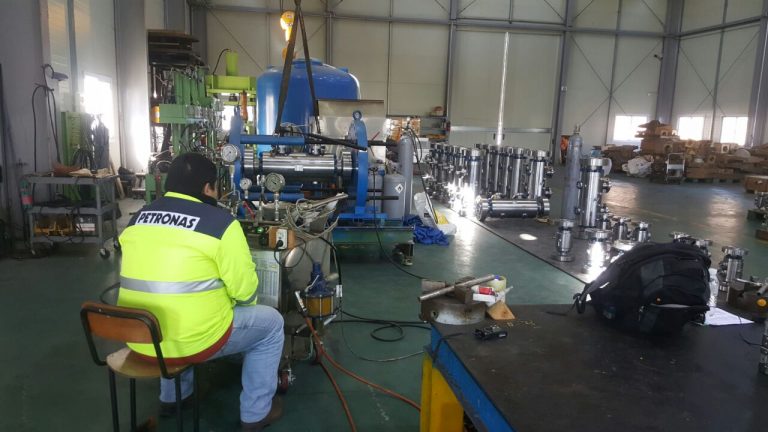Copyright © 2023 Oil City Technology Sdn Bhd, All rights reserved.

The Factory Acceptance Test (FAT) is a process that evaluates the equipment during and after the assembly process by verifying that it is built and operating in accordance with design specifications. FAT ensures that the components and controls are working properly according to the functionality of the equipment itself. As the name suggests, this testing is performed at the factory. The FAT is not a requirement but recommended to be carried out.
Factory Acceptance Test (FAT) of the valves is normally done after assembling and before painting mainly to make sure that the leakage rate(s) from the body and the seats of the valve are within the accepted limits.
API 598 and API 6D are the main standards of industrial valves testing. The valve manufacturer shall prepare a test procedure based on the above mentioned standards and the client requirements. The test procedure should be approved prior to the test.
FAT is not limited to pressure tests. Functional test of the valves including opening and closing time measurement of the actuated valves, torque measurement, valve and actuator dimensional check based on general arrangement drawings, checking the materials based on detail drawings, material and internal test certificates checking, etc. are generally done during the FAT.
When it comes to pressure test, high pressure hydro-static test (1,5 x Design pressure) on body, hydrostatic test on the seats (1,1 x Design pressure) are always done. Maybe low pressure air test with 4-7barg on seats and high pressure gas test (1,1x Design pressure) are done after hydro static test. The other tests could be cavity drain test for DIB valves.
Low pressure air test after hydrotest is recommended since air can detect sometimes leakages from the seats that already passed the hydrotest. Unlike low pressure air test, High pressure gas test should be kept as minimum as possible since this test is expensive, requires high safety precaution and could affect the delivery time of the valve.
The water of the test is recommended to have low chloride level (e.g. 30 ppm maximum) with addition of corrosion inhibitor (3% as an example). It is important that the valve will be clean of particles and be dried after the test to avoid corrosion. The other important point is that the pressure gauges and other measurement tools like torque measurement tool should be certified and calibrated valid for the time of test.
The other activities during the FAT in addition to what was mentioned above could be check the markings on the valve parts (e.g. serial number on the body), visual examination, flange roughness checking, etc.
FAT’s are beneficial not just for the buyer and end users but for the manufacturer as well. Both parties can be assured that the equipment meets all the contractual specifications and any issues can be addressed before arriving at the customer’s site. Rectifying issues while the system is still in the possession of the manufacturer helps to keep the project on track and within budget. FATs almost always save time and money over fixing issues in the field.
Our broad factory acceptance test is the most lucrative way to ensure that your equipment or plant operates correctly. As a highly qualified, independent third-party, we have the trusted skills and resources to perform steadfast testing. Alternatively, we can witness appropriate testing on your behalf. In many cases it is difficult to predict the correct operation of the safety instrumented system or consequences due to failures in some parts of the safety instrumented system. For that reason the FAT is a valuable check of the safety issues.
The safety of your employees is always a top concern so the quality assurance gives you the peace of mind that all components of your system are functioning the way they should, and within the full range of operating specifications.
There are several components that make up FAT. The product must be assembled, prepared, and connected to utilities for testing. Documentation such as drawings, ASME certificates, and test procedures must be gathered. And finally, testing must be conducted in the factory that follows specific test procedures.
Before the FAT begins, the manufacturer should present the FAT procedure to the client for review and approval. The procedure should include testing of as much functionality as is practical in the factory and, where possible, should show pass/fail criteria or desired results for each item tested. Once the procedure is approved, the manufacturer should test the equipment before the FAT begins.
All our product range is available if FAT is required. please let us know during the tendering or bidding stage to include the FAT cost in our proposal.
We offer a professional service to all our clients and aim to deliver as quickly as possible. We are always available to answer any of your enquiries regarding our range of products & services.